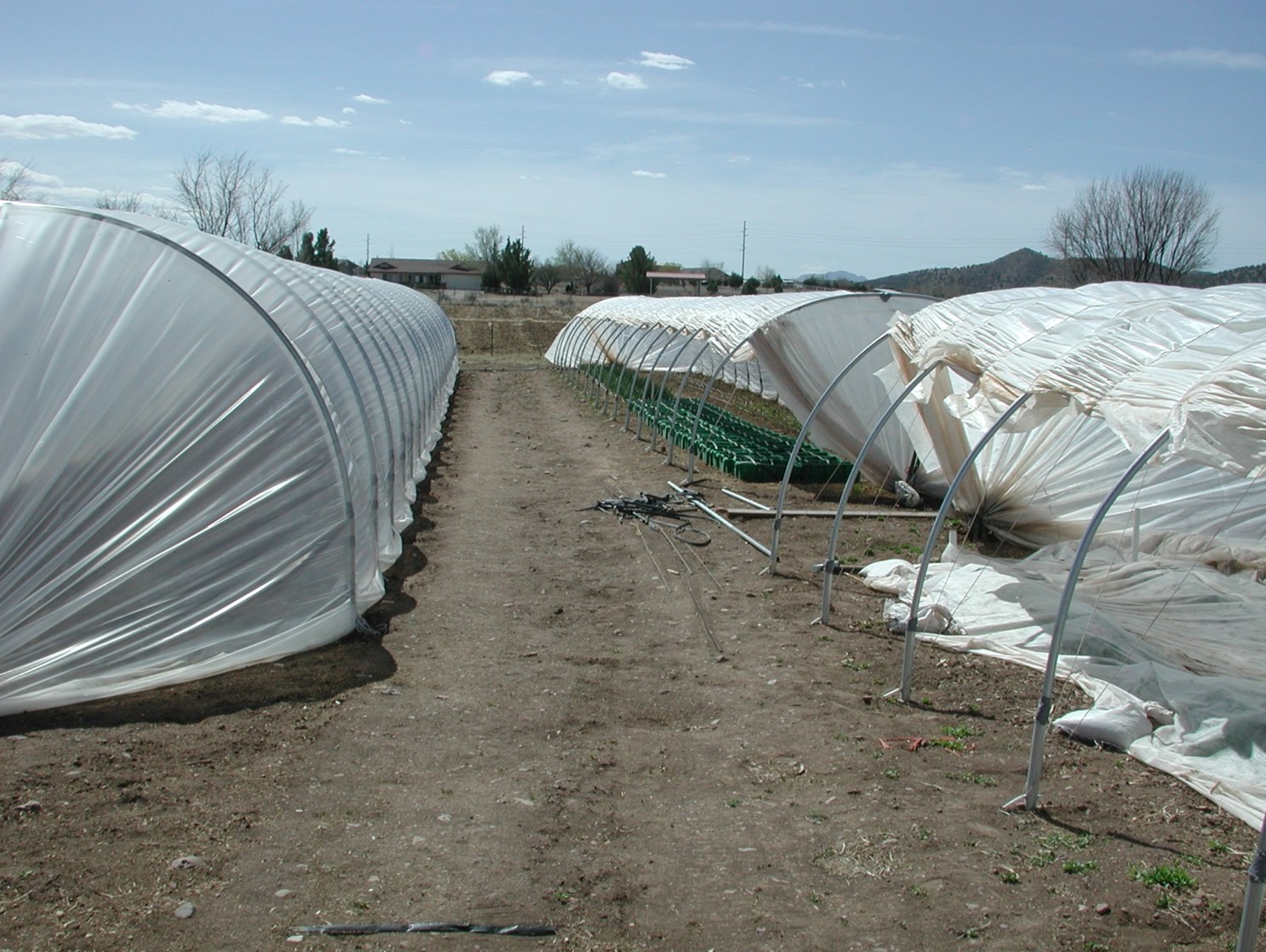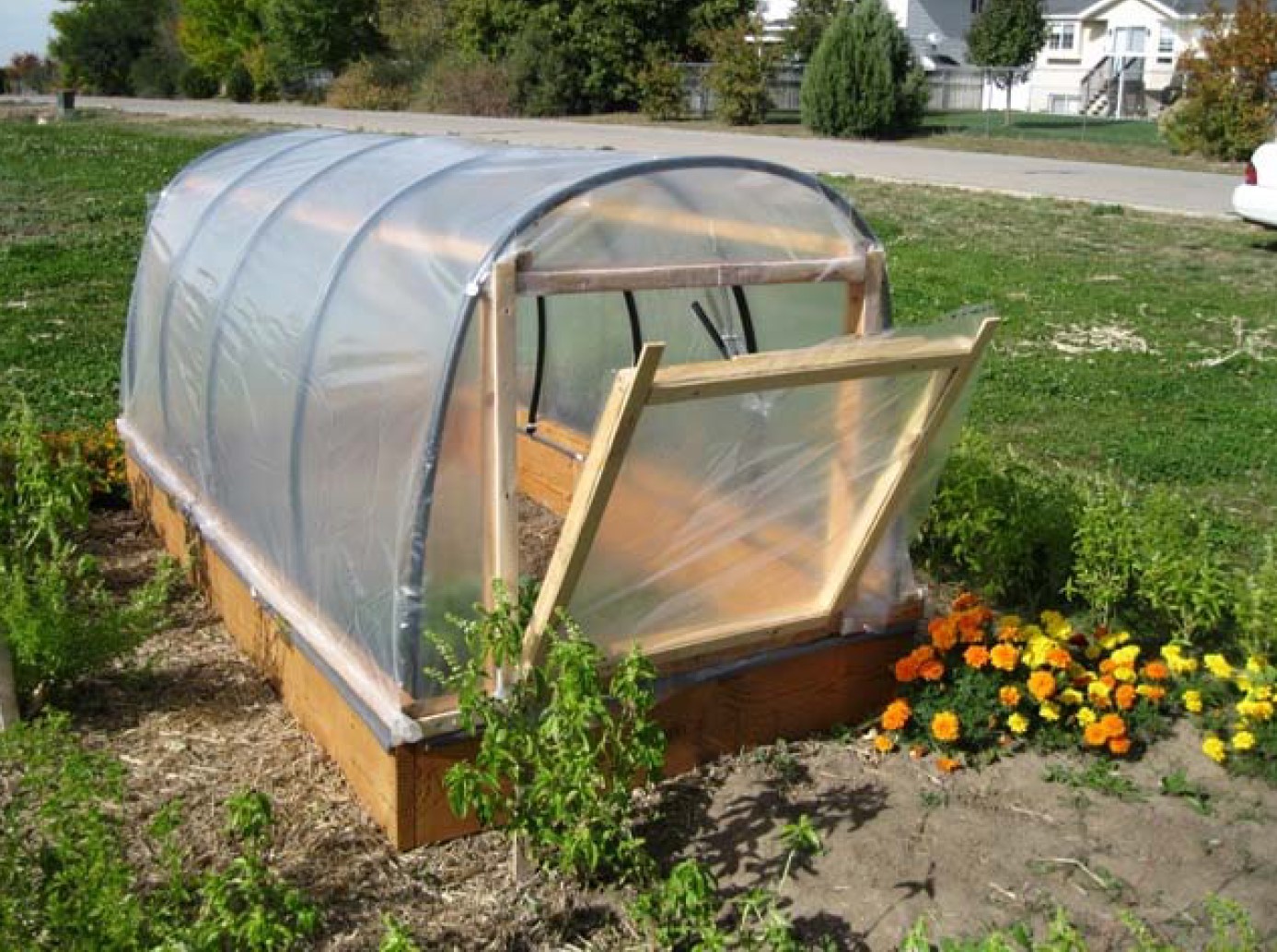 High Tunnels Extend Growing Season - October 28, 2020 Jeff Schalau, Agent, Agriculture & Natural Resources University of Arizona Cooperative Extension, Yavapai County High tunnels are low tech, greenhouse-like structures that can be used for starting seedlings, growing vegetables, or perennial crops. A high tunnel (also called a hoop house) can significantly extend the spring and fall growing seasons while also increasing air and soil temperatures for improved plant growth. They are easily constructed and can last many years. The dimensions can be adjusted to fit personal needs and available space. After seeing a high tunnel being constructed in my neighborhood, I thought readers may want to consider building one. High tunnel sizes range from 14 ft wide by 20 ft long and can be modified to be 100 ft long or more. The most common, inexpensive high tunnel designs use PVC pipe to support the plastic cover and two end walls that provide access and stability. In Arizona, it is also important to design the high tunnel so the sides can be rolled up to provide ventilation during warmer weather. This column will reference publications from Utah State University which include materials lists and instructions to build several high tunnel designs. These publications are linked below. Take care when selecting the high tunnel site as they are not easily moved. The site should be level and have well-drained soils that are free of rock/gravel, known plant pathogens, and perennial weeds. The site should not be shaded, particularly on the south and west sides. The site also needs to be located near a year-round water source. Tools needed include: circular saw, electric drill and bits, sledgehammer, square, tin snips, socket wrenches, and a few other common hand tools. For the smaller designs, end walls and doors can be constructed by one person, extra help will be needed to cover the tunnel with plastic and to fasten the plastic to the end walls. It is best to begin by building the two ends which are identical and made from lumber. Redwood or treated lumber can be used where the wood will be in contact with the soil. The 1” schedule 40 PVC pipe will create the hoops which should be coated with white exterior latex paint to prevent photodegradation of the plastic. Make sure you glue the PVC before you paint. The various high tunnel designs provided have differing heights depending on crops to be grown. The tall designs have straight side walls which allow the grower more freedom of movement when working inside. A wind proof design is also provided. Once the ends are built, the area can be staked off and the ends placed and secured to the ground. It is important that the corners be square – this can be checked by measuring from corner to opposite corner crosswise. The PVC hoops are secured to the ground by pounding 24-inch lengths of ½ inch rebar 18 inches into the ground. Gently slide the lengths of PVC over the 6 inches of rebar that remains above ground to hold each hoop in place. The plastic sheeting should be UV resistant and at least 6 mil thick. Have some friends handy to attach the plastic sheeting to one end wall and over the hoops then to the other end wall. Wiggle wire and track are specialty products available from greenhouse supply companies which can be used to attach plastic sheeting. Nylon twine is tied to the rebar stakes and run on the outside of the high tunnel for added stability and to keep the plastic taut. The twine should be just loose enough to allow slipping the polyethylene plastic up when raising the sides of the high tunnel for ventilation. As you may imagine, I have left many details out. However, the Utah State High Tunnel website provides those details. Consider including electrical power for lighting and/or power tools. Shade cloth can be added in summer to decrease solar radiation and subsequent heat. Some growers remove the plastic sheeting during warm weather to allow greater flexibility. I’ve also seen floating row cover used inside the high tunnel where there are extreme cold conditions. In my opinion, high tunnels are much less expensive and more practical/adaptable than prefabricated greenhouses – especially for backyard food production. I’ve seen many home greenhouses that cannot be adequately cooled in summer and go underutilized. You can follow the Backyard Gardener on Twitter – use the link on the BYG website. If you have other gardening questions, email the Master Gardener Help Desk in Prescott (prescottmg@gmail.com) or Camp Verde (verdevalleymg@gmail.com) and be sure to include your name, location, and phone number. Find past Backyard Gardener columns or provide feedback at the Backyard Gardener web site: https://cals.arizona.edu/yavapai/anr/hort/byg/. Images  High tunnel with end-walls (photo by University of Arizona).
High tunnel with end-walls (photo by University of Arizona). High tunnels without endwalls at Whipstone Farm, Paulden, AZ. This design is called a "caterpillar tunnel" and hoops are metal "toprail" used in chain link fence construction. A "hoop bender" is used to create arched tubes. Tunnels on right do not have vertical poles at the base and are more difficult to move around in. The newer tunnel on the left has short vertical pole extensions to provide better working space near the outer walls. Caterpillar tunnels are accessed by lifting the side walls (Photo by Jeff Schalau, University of Arizona).
High tunnels without endwalls at Whipstone Farm, Paulden, AZ. This design is called a "caterpillar tunnel" and hoops are metal "toprail" used in chain link fence construction. A "hoop bender" is used to create arched tubes. Tunnels on right do not have vertical poles at the base and are more difficult to move around in. The newer tunnel on the left has short vertical pole extensions to provide better working space near the outer walls. Caterpillar tunnels are accessed by lifting the side walls (Photo by Jeff Schalau, University of Arizona). Small self-venting garden tunnel. This is a great design for backyard enthusiasts and is described in detail at the Utah State University Extension link below (Photo by Utah State University).
Small self-venting garden tunnel. This is a great design for backyard enthusiasts and is described in detail at the Utah State University Extension link below (Photo by Utah State University).Additional Resources Specialty Crop Production Practices for Beginning Farmers in Arizona and the Southwest, University of Arizona Cooperative Extension extension.arizona.edu/sites/extension.arizona.edu/files/pubs/az1774-2018.pdf High Tunnel Construction and Modifications, Utah State University Extension extension.usu.edu/productionhort/high-tunnel/construct High Tunnels and Other Season Extension Techniques, Sustainable Agricultural Research and Education (SARE) www.sare.org/resources/high-tunnels-and-other-season-extension-techniques/ |